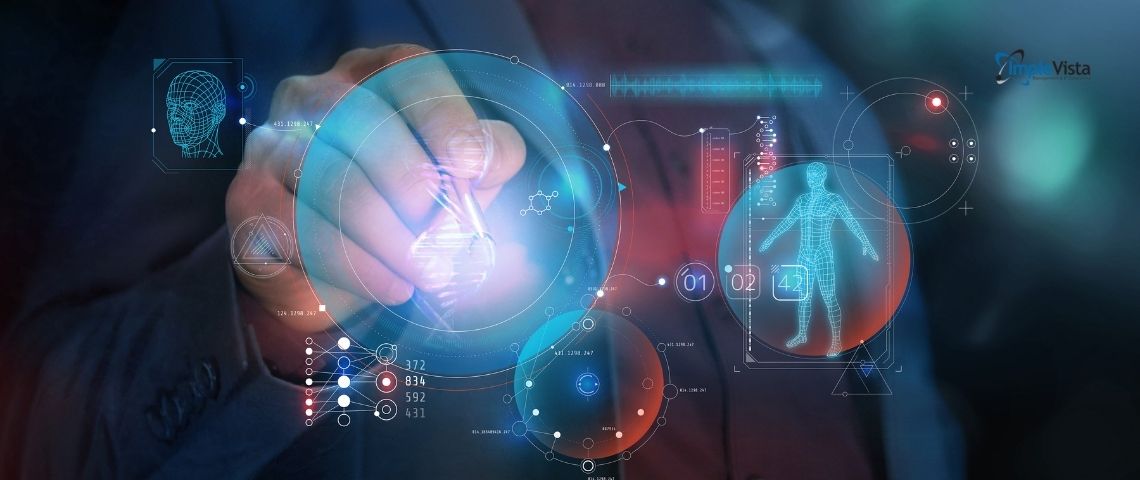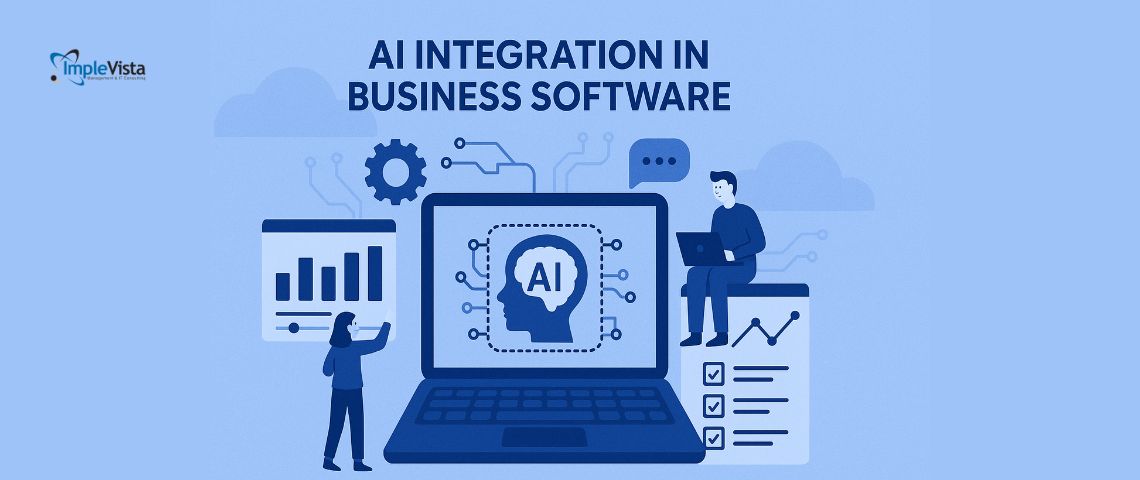Modern organizations are rapidly embedding AI power into custom software. In fact, recent industry surveys show that 73% of technology leaders have made expanding AI use their top priority, and by 2025 about 75% of companies will be already applying AI in development workflows.
These trends underscore the urgency of adding machine learning features—such as personalized recommendations, natural language processing (NLP), and computer vision—to software solutions. In this article, we’ll explore how to harness AI power in custom applications, illustrate concrete use cases (like smart dashboards and predictive analytics), and highlight why ethical AI practices and governance are essential for success.
The Rise of AI Powered Applications
Organizations across industries are experiencing an AI revolution. As Implevista notes, AI and ML have become core elements of modern software, refining user experiences and business processes. A Gartner survey found that 85% of customer interactions are expected to be handled without a human agent by 2025, reflecting widespread adoption of chatbots and automation.
Moreover, industry research highlights that 73% of tech leaders now prioritize expanding AI in their companies, and many have already integrated AI into software creation (75% in 2024). In other words, AI-powered applications are no longer optional – they are a strategic imperative.
AI-driven capabilities empower custom software to automate routine tasks, unlock data insights, and personalize experiences. For example, machine learning models can analyze historical data to forecast trends, and NLP engines can enable natural language interfaces.
Implevista’s own development teams leverage these technologies: “AI plays a pivotal role in enhancing our custom software development services,” automating code generation, testing, and maintenance. By harnessing AI power such as ML algorithms and NLP, businesses can build smarter, more efficient applications.

Key AI/ML Features for Custom Software
Software developers can integrate a variety of AI/ML features to make applications AI-powered and intelligent. Below are several core components and use cases to consider:
- Recommendation Engines (Personalization): Machine learning recommendation systems analyze user behavior and preferences to suggest products, content, or services. For instance, streaming platforms like Netflix and Spotify use ML models to recommend movies or songs based on user history. Similarly, e-commerce applications can embed recommenders that learn from purchase patterns and browsing data, tailoring suggestions in real time. These AI-powered recommendations increase user engagement and loyalty by making software feel personalized.
- Natural Language Processing (NLP): NLP enables software to understand and generate human language. AI-powered chatbots and virtual assistants, for example, use NLP to handle customer inquiries, tech support, or FAQ interactions. As Implevista explains, “NLP in custom software development can help develop applications like chatbots, virtual personal assistants, and more… improving user experience”. By integrating NLP, applications can analyze text data, extract insights (like sentiment or entities), and allow users to interact via voice or text conversationally. Gartner predicts that intelligent virtual assistants will handle 85% of service interactions by 2025, highlighting the value of NLP in automating support.
- Computer Vision: Computer vision lets applications interpret images and video. AI-powered CV can perform tasks like image recognition, object detection, and image segmentation. For example, in manufacturing, CV systems inspect products for defects; in retail, shelf-monitoring cameras track inventory; and in healthcare, AI analyzes medical images for diagnostics. According to IBM, “AI-powered computer vision enables image segmentation… use cases including aiding diagnosis in medical imaging, robotics and self-driving cars, identifying objects in satellite images, and photo tagging in social media”. By embedding CV models, software gains vision capabilities – for instance, an app could “see” and react to on-screen information or use a device camera for AR features.
- Predictive Analytics & Smart Dashboards: Machine learning models can predict future outcomes and trends based on data. Predictive analytics is a hallmark of AI-powered applications. For example, ML can forecast customer demand, equipment failures, or market trends from historical data. These predictions feed into intelligent dashboards that visualize analytics in real time.
- A compelling case study comes from a pharmaceutical company: Implevista’s partner built an AI-driven smart dashboard that consolidated years of data and ran ML models to forecast drug demand and streamline operations. The dashboard let managers simulate “what-if” scenarios and get live predictive insights on market trends and resource needs. As a result, leadership made faster, data-driven decisions, optimizing production schedules and cutting costs. This real-world example shows how integrating predictive ML into business dashboards creates a smarter, responsive application.
- Automated Support & Chatbots: Beyond NLP, AI can automate interactions. An AI-powered chatbot embedded in software provides 24/7 support, answers questions, and handles tasks without human intervention. For example, banks and e-commerce sites use chatbots to guide users through forms or troubleshoot issues, reducing workload on human staff. Implevista’s research notes that businesses are increasingly relying on such automation, and AI chatbots will handle 85% of customer interactions by 2025. In custom applications, integrating an AI chatbot module allows software to interact naturally with users, improving service and engagement.
- Fraud Detection and Security: Machine learning models excel at detecting anomalies and fraud. Software in finance or transactions can use AI to monitor patterns and flag suspicious activity. For example, AI algorithms can scan streams of transactions to spot irregularities faster than manual methods. This not only protects users but also builds trust. Indeed, many companies now integrate AI modules for cybersecurity, leveraging ML to classify threats or intrusions in real time. Embedding these AI-driven security features can make custom software more robust.
- Robotic Process Automation (RPA): While not exactly new ML, integrating RPA with AI is also powerful. Implevista highlights RPA as one emerging technology: RPA bots handle repetitive data tasks, which can be “AI-powered” by incorporating cognitive components (e.g., interpreting unstructured documents). For instance, in a finance app, an AI agent could auto-process invoices and reconcile accounts, using ML to interpret text on forms. The combination of RPA and AI saves time and reduces errors in administrative workflows.
In summary, embedding these AI/ML features transforms ordinary software into AI-powered applications. Developers often use cloud-based AI services or open-source libraries to integrate functionalities like recommendation APIs, TensorFlow/PyTorch models, or NLP toolkits. The key is designing software architecture that feeds data to ML models and uses their output to augment features. Implevista’s teams, for example, combine cloud engineering and data pipelines to host models, and build mobile/IoT frontends that utilize those AI services seamlessly (see our Cloud Engineering and Mobility offerings).

Real-World AI Use Cases
To ground these ideas, here are concrete examples of AI power in action:
- E-commerce Personalization: An online store built on Implevista’s iVCommerce platform can employ an ML recommender to suggest products. The system learns from each customer’s purchases and viewing history, then displays personalized product carousels. This AI-driven personalization increases sales and keeps customers engaged.
- Smart Business Dashboards: A manufacturing company’s enterprise software can include a dashboard that uses predictive models for maintenance. For example, sensors on equipment feed data to an ML model that predicts failure. The dashboard then alerts managers when maintenance is needed – automating what was once a manual check.
- Customer Support Chatbots: A travel agency using the IV Trip system offers an AI chatbot on its website to answer booking queries. As the [IV Trip AI guide] notes, features include personalized travel recommendations and 24/7 AI chat assistants. In one case study, integrating IV Trip’s chatbot and dynamic pricing engine led to 40% higher customer satisfaction and a 35% cost reduction.
- Healthcare Diagnostics: A custom telemedicine app might use computer vision to analyze medical scans. An ML model trained to detect anomalies in X-rays or MRIs can assist doctors by highlighting areas of concern, speeding up diagnosis.
- Finance and Accounting: In financial software, machine learning models can automate credit scoring or fraud checks. For instance, Implevista’s iQuidi Accounting solution could integrate an AI module that flags unusual transactions. According to Implevista’s blog, “AI in software solutions has transformed fraud detection systems… It scans transactions, recognizes irregularities, and reverses fraudulent entries.” Embedding such a model adds security to the finance workflow.
- Mobility and IoT: Mobile apps developed by Implevista can use on-device ML for tasks like image recognition (e.g., analyzing photos captured by a user). Similarly, IoT devices can send data to cloud AI services for analysis. For example, an agricultural management app might use a camera and a CV model to detect crop disease in field photos.
These use cases show that AI-powered applications are versatile. Whether enhancing customer-facing features (like chatbots and recommendations) or optimizing backend operations (predictive analytics, automation), machine learning can be integrated at many levels. Implevista’s broad service portfolio supports this: from Business Analytics for data-driven insights, to our specialized Custom Software development, clients can embed AI into almost any solution we build.

Implementing AI: Technical Considerations
When adding AI/ML features, teams should plan carefully:
- Data Requirements: ML models need data. Ensure your software collects and stores relevant data (user behavior, sensor readings, transaction logs). Clean, high-quality data sets are critical. As one Implevista article notes, a key challenge is data quality and availability. Investing in databases and ETL processes early can pay off.
- Integration: Embedding AI means calling ML models from your app. This might be via REST APIs to cloud services (AWS SageMaker, Google AI, Azure ML) or running models in-process with libraries. Implevista’s cloud engineering services can help architect these integrations. Aim to make AI components modular: for example, separate microservices for recommendation engines or vision analysis.
- Scalability: AI computations (especially deep learning) can be resource-intensive. Use scalable infrastructure so that model processing can grow with usage. Techniques like serverless inference or GPU-backed servers may be needed. Implevista’s Cloud Engineering solutions can manage scalable AI deployments.
- Maintenance: ML models require ongoing training and tuning. Plan for versioning models and re-training on new data. Model governance (see below) will help track model changes.
- User Experience: Seamless AI integration means hiding complexity from users. For example, if adding a chatbot, design a clear UI; if adding recommendations, label them “Recommended for You.” Test features thoroughly to ensure they improve UX.
By addressing these technical factors, custom software can effectively incorporate AI power. The result is applications that continually learn and improve.

Smart Dashboards and Predictive Analytics
A standout AI use case is smart dashboards that do more than display data. These dashboards use ML to predict and prescribe actions. For example, a sales analytics dashboard might use regression models to forecast next quarter’s revenue, alerting managers to trends and suggesting inventory adjustments. These interactive dashboards can allow users to run “what-if” scenarios: “If we increase marketing spend by 10%, what sales lift can we expect?” Behind the scenes, the dashboard queries an ML model and visualizes the predicted outcomes.
This concept is proven in industry. As one case study highlights, an AI-driven smart dashboard built for a pharmaceutical client consolidated 20 years of data. The ML models forecasted drug demand and clinical trial success rates. Managers could see real-time predictions and adjust production plans accordingly. The result: 40% more accurate forecasting and significant cost savings. Similarly, logistics companies use dashboards that predict delivery delays based on weather and traffic data, and finance apps forecast cash flow for CFOs.
Implementing predictive dashboards usually involves a BI front-end (Power BI, Tableau, or a custom UI) connected to an ML engine. Data pipelines feed the models in real time. Implevista’s Business Analytics team is experienced in building such systems. We often use open-source ML (e.g., Python scikit-learn or TensorFlow) and then deliver the predictions via APIs to the dashboard interface. The key benefit is proactive decision-making: instead of just looking at historical data, managers act on AI-driven forecasts.
Ethical AI and Model Governance
With great AI power comes responsibility. Experts stress that companies must use AI ethically and transparently. In the 2025 survey by Infragistics, while leaders prioritized AI, they also identified data privacy, bias, and errors as major risks. Casey Ciniello of Infragistics emphasizes that “Organizations must implement governance frameworks and technical safeguards to ensure safe, strategic implementation”. In practice, this means:
- Fairness: Ensure ML models do not perpetuate bias. For example, a hiring app must avoid gender or racial bias in its recommendations. This requires training models on representative data and auditing outputs.
- Transparency: Document how models make decisions. Keep logs of model inputs/outputs. This is especially crucial in regulated industries (finance, healthcare). Governance frameworks track model versions and feature sets.
- Accountability: Assign ownership of each model. If an AI feature causes an issue, it must be clear who is responsible. Implevista supports clients by helping define roles: data scientists, data engineers, product owners who oversee AI components.
- Security & Privacy: Protect sensitive data used by AI. Techniques like differential privacy or secure enclaves can be used. In the survey, 78% of leaders cited privacy as the top AI concern, so encryption and access controls are a must.
- Ethical Guidelines: Many organizations publish AI ethics guidelines (no harm, fairness, human oversight). Implevista recommends crafting a clear policy before rolling out AI features. For example, insist on human review for critical decisions (e.g., loan approvals) and give users opt-outs where necessary.
Together, these practices fall under AI governance or model governance. This means not only building models, but also monitoring them in production – checking for drift (model performance degradation over time) and retraining if needed. By adopting governance best practices, businesses ensure their AI-powered applications are trustworthy and aligned with values.
Challenges and Best Practices
While AI offers many benefits, integrating it into software has challenges. Common issues include:
- Data Quality and Volume: Models need lots of good data. Gathering, cleaning, and labelling data can be time-consuming. Best practice: start data collection early and iterate.
- Integration Effort: Adding AI to an existing system can be complex. Legacy platforms may not support new APIs or data flows. Implevista often recommends a phased approach, using microservices or separate AI modules that communicate with the main app.
- Resource Costs: Training ML models (especially deep learning) can require GPUs and time, meaning higher upfront investment. Organizations should budget for this. However, cloud platforms now offer on-demand ML infrastructure, reducing capital costs.
- Skill Gaps: Building AI features requires expertise. Many firms lack in-house ML talent. Here, outsourcing or partnerships can help. Implevista provides experienced ML engineers and data scientists who can augment a client’s team (see our Development Team service).
- Change Management: Introducing AI changes processes. Staff need training on new tools (e.g., data scientists must learn the business context; business users must trust AI insights). It’s important to educate teams on the capabilities and limits of AI.
By acknowledging these challenges and planning for them, companies can more effectively power their applications with AI. In our projects, Implevista emphasizes iterative development: start with a pilot AI feature (e.g., a basic recommender or proof-of-concept model), test it with real users, then expand. This agile approach helps catch issues early and demonstrate value quickly.
Enhancing Digital Marketing with AI
While our focus is on custom software, it’s worth noting that AI-powered techniques also transform marketing technology. Implevista’s digital marketing arm shows how AI/ML can optimize websites and campaigns. For example, “AI in SEO uses advanced tech like machine learning and natural language processing… to process large amounts of data, uncover trends, and offer smart suggestions”.
In practice, digital teams use AI tools to find high-value keywords, automate content tagging, and run analytics on user behavior. These same AI methods (ML/NLP) can be integrated into business apps – illustrating how AI power crosses domains from marketing to backend operations.
Conclusion and Next Steps
Integrating AI power into custom software opens up transformative possibilities: smarter personalization, advanced analytics, and automated workflows. Data shows that most tech leaders are already moving in this direction. By adding recommendation engines, NLP interfaces, computer vision modules, and predictive dashboards, your software can adapt and improve with usage. Importantly, following ethical AI and governance best practices will ensure these innovations build trust rather than risk.
At Implevista, we specialize in building AI-powered applications tailored to business needs. Our teams combine expertise in cloud engineering, IoT solutions, and analytics to seamlessly embed ML features. Whether you need an intelligent mobile app, an AI-driven business intelligence dashboard, or an ecommerce platform with smart recommendations, we can help.
Ready to unlock the power of AI in your software? Contact Implevista today to discuss your project and explore our AI integration services. You can also subscribe to our blog for more articles on AI and software development. For a specific example, read about how AI powers our travel agency management system, IV Trip. Let Implevista help you harness AI to innovate, compete, and grow.

FAQ: AI-Powered Applications
Q: What are AI-powered applications?
AI-powered applications are software programs that include artificial intelligence or machine learning features. They use algorithms like recommendation engines, NLP, and computer vision to perform tasks that typically require human intelligence.
Q: How can I integrate machine learning into custom software?
Integration typically involves feeding your application’s data into ML models. You can use cloud AI services (AWS, Azure, Google) or embed open-source models. The app sends data to the model via an API or library call and uses the model’s output (predictions or insights) in the user interface or business logic.
Q: What are examples of AI/ML features in custom software?
Common examples include personalized recommendation systems (e.g., product recommendations), NLP chatbots or text analysis, computer vision (e.g., image recognition), and predictive analytics dashboards. For instance, an AI chatbot can automate customer support, while a predictive model can forecast sales from past data.
Q: What is a recommendation engine?
A recommendation engine uses machine learning to suggest items to users. For example, it might analyze a user’s past purchases or clicks and recommend related products. Streaming services use similar engines to suggest videos or music, and e-commerce apps use them to personalize shopping.
Q: How do chatbots use NLP?
Chatbots use Natural Language Processing (NLP) to understand user queries and generate responses. The chatbot takes the user’s text or voice input, processes it through an NLP model to interpret intent, and then replies appropriately. This allows the chatbot to handle support tickets or questions in natural language.
Q: What is computer vision and how is it used?
Computer vision (CV) is an AI technology that enables software to interpret images or video. CV can be used for tasks like object recognition, facial recognition, or scene analysis. For example, a healthcare app might use CV to detect anomalies in X-ray images, or a retail system might use it to check product quality on an assembly line.
Q: What are smart dashboards?
Smart dashboards are data dashboards enhanced with AI. They not only display KPIs and charts but also include predictive analytics and “what-if” simulations powered by ML models. For instance, a smart dashboard might project future sales or alert you to anticipated issues. The dashboard we built for a pharma client delivered real-time predictive insights to improve decision-making.
Q: Why is ethical AI important?
Ethical AI ensures that AI models are fair, transparent, and secure. It prevents biased or harmful outcomes. According to industry experts, implementing governance frameworks and safeguards is essential when expanding AI. Ethical practices (like transparency and bias-checking) help maintain user trust and compliance with regulations.
Q: What is AI model governance?
Model governance refers to overseeing AI/ML models throughout their lifecycle. This includes tracking data sources, validating model performance, ensuring explainability, and managing updates. Organizations often set guidelines to govern AI usage, ensuring models remain accurate, unbiased, and secure.
Q: Can small businesses benefit from AI-powered software?
Yes. AI and ML can scale to any size. Small businesses can use AI to automate routine tasks, personalize customer experiences, or analyze data they already have. There are many off-the-shelf AI solutions and affordable cloud services that make it practical for businesses of all sizes to adopt AI features.
Industry surveys and expert analyses provide evidence of growing AI adoption. Implevista’s own research and case studies demonstrate practical AI integrations. For further reading, see Implevista’s blog posts on AI in software and our IV Trip AI travel guide.




